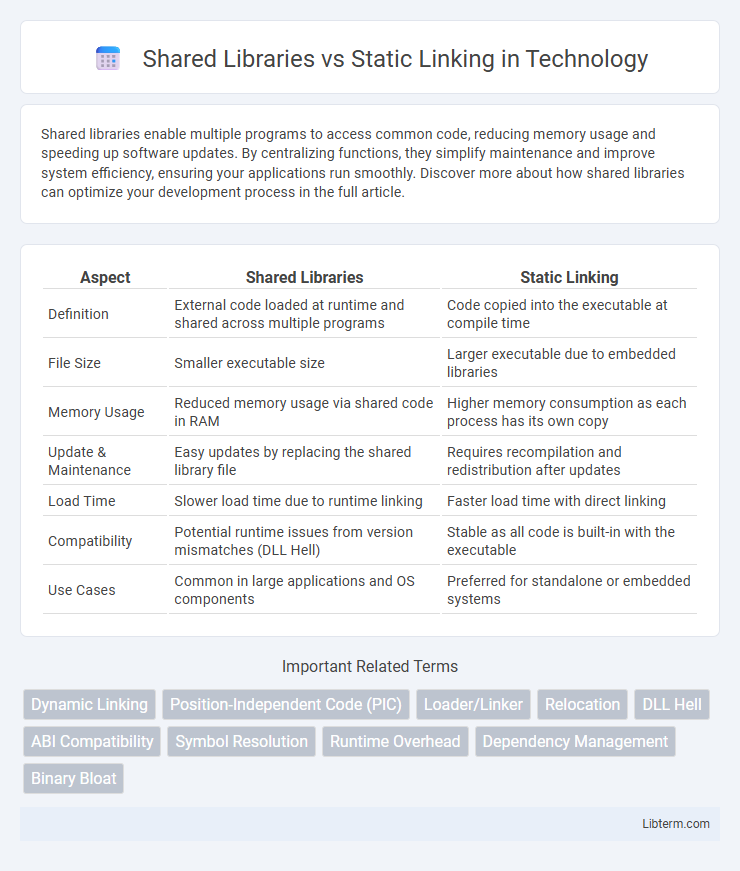Shared libraries enable multiple programs to access common code, reducing memory usage and speeding up software updates. By centralizing functions, they simplify maintenance and improve system efficiency, ensuring your applications run smoothly. Discover more about how shared libraries can optimize your development process in the full article.
Table of Comparison
| Aspect | Shared Libraries | Static Linking |
|---|---|---|
| Definition | External code loaded at runtime and shared across multiple programs | Code copied into the executable at compile time |
| File Size | Smaller executable size | Larger executable due to embedded libraries |
| Memory Usage | Reduced memory usage via shared code in RAM | Higher memory consumption as each process has its own copy |
| Update & Maintenance | Easy updates by replacing the shared library file | Requires recompilation and redistribution after updates |
| Load Time | Slower load time due to runtime linking | Faster load time with direct linking |
| Compatibility | Potential runtime issues from version mismatches (DLL Hell) | Stable as all code is built-in with the executable |
| Use Cases | Common in large applications and OS components | Preferred for standalone or embedded systems |
Introduction to Shared Libraries and Static Linking
Shared libraries are external files containing compiled code loaded at runtime, enabling multiple programs to use the same code, reducing memory usage and facilitating updates without recompilation. Static linking incorporates all required library code directly into the executable at compile time, resulting in larger binaries but eliminating dependencies on external files during execution. Choosing between shared libraries and static linking impacts application size, memory efficiency, and deployment flexibility.
Understanding Library Linking in Software Development
Shared libraries enable multiple programs to use the same code at runtime, reducing memory usage and easing updates by modifying the library independently of the applications. Static linking incorporates all library code into the final executable at compile time, increasing binary size but ensuring consistent behavior without relying on external files. Understanding the trade-offs between shared libraries and static linking is crucial for optimizing software performance, compatibility, and ease of maintenance.
How Shared Libraries Work
Shared libraries operate by loading a single copy of the code into memory during runtime, allowing multiple programs to access the library's functions dynamically. The dynamic linker/loader resolves symbol dependencies when an application starts or during execution, facilitating memory efficiency and easier updates without recompiling dependent programs. This method contrasts with static linking, where library code is copied directly into the executable, increasing file size and reducing flexibility.
How Static Linking Works
Static linking works by embedding all required library routines directly into the executable file at compile time, creating a self-contained program without external dependencies. The linker collects the necessary object code from static libraries, combines them with the application's code, and produces a single binary that includes everything needed for execution. This results in faster startup performance and simplified distribution but increases the executable size and lacks flexibility for library updates.
Key Differences between Shared Libraries and Static Linking
Shared libraries are dynamically linked during runtime, enabling multiple programs to share a single copy of the library code, which reduces memory usage and disk space. Static linking incorporates all library code directly into the executable at compile time, resulting in larger binary sizes but improved performance and portability. Key differences include update flexibility--shared libraries can be updated independently without recompiling applications, whereas statically linked programs require recompilation to incorporate library changes.
Advantages of Using Shared Libraries
Shared libraries reduce memory usage by allowing multiple programs to share a single copy of the library code, enhancing system efficiency and reducing overall resource consumption. They facilitate easier updates and maintenance, as bug fixes or feature improvements in the shared library automatically propagate to all dependent applications without recompilation. Dynamic linking also speeds up the build process and minimizes executable file sizes, providing benefits in both development and deployment environments.
Benefits of Static Linking
Static linking embeds all necessary libraries directly into the executable file, resulting in faster program startup and improved runtime performance due to the elimination of dynamic symbol resolution. This approach enhances application portability and reliability by ensuring the binary is self-contained, avoiding dependency issues on target systems. Static linking also simplifies software deployment and reduces the risk of version conflicts or missing shared libraries during execution.
Performance Comparison: Shared vs Static Linking
Static linking generally offers faster execution times since all necessary code is included directly in the executable, reducing runtime dependencies and eliminating dynamic symbol resolution overhead. Shared libraries provide memory savings and enable smaller executable sizes, but their performance can be slightly impacted by runtime linking and symbol lookups during program startup or calls. In scenarios demanding optimal speed and minimal latency, static linking is preferred, whereas shared libraries excel in memory efficiency and modular updates.
Security Implications of Each Approach
Shared libraries reduce overall binary size and allow for centralized updates, but they introduce security risks such as dependency hijacking and runtime injection attacks due to code being loaded dynamically. Static linking embeds all needed code into the executable, offering better isolation and reducing exposure to external tampering, but it increases the binary size and complicates patching vulnerable library versions. Effective security strategies require careful management of shared library versions and integrity checks to mitigate potential exploits from both approaches.
Choosing the Right Linking Method for Your Project
Choosing the right linking method depends on factors such as application size, update frequency, and memory constraints. Shared libraries reduce executable size and allow easier updates by loading common code at runtime, but may introduce dependency management challenges and runtime overhead. Static linking embeds all necessary code within the executable, resulting in larger files and faster startup times, offering better portability and fewer external dependencies for isolated or performance-critical projects.
Shared Libraries Infographic

 libterm.com
libterm.com